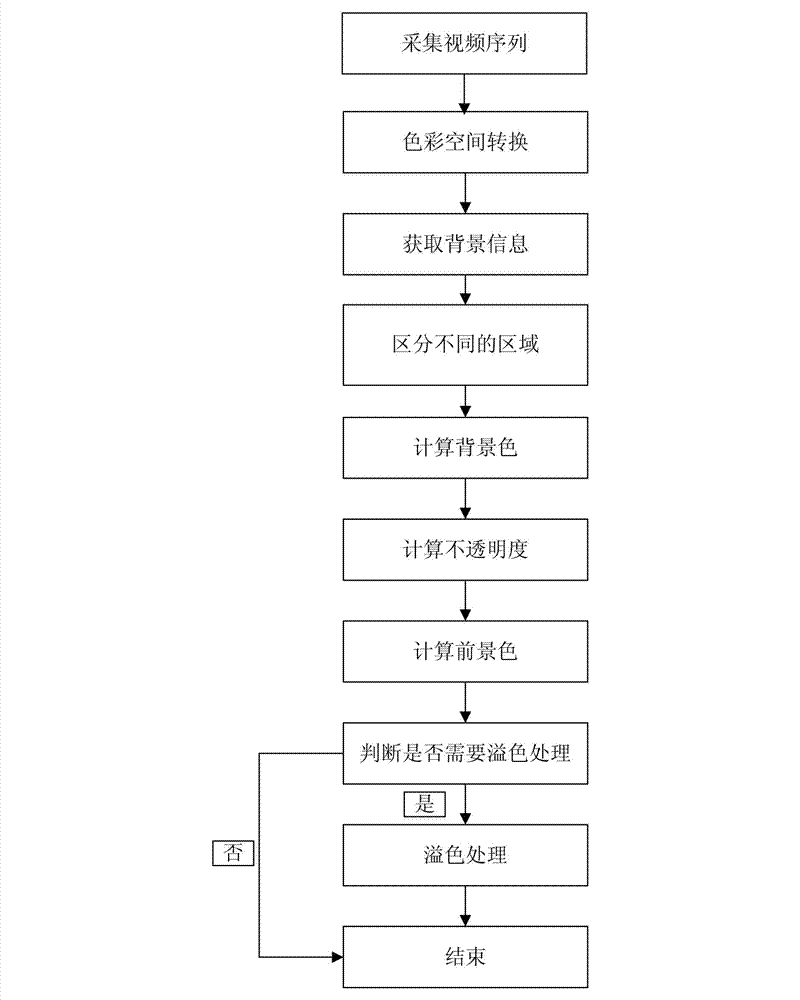Video image matting method based on three elements of color
A three-element, video technology, applied in color TV, color TV parts, TV and other directions, can solve the problems of lack of universality, tedious work of matting, inability to deal with background color, etc., to restore color and transparency, improve Processing effects, improving visual effects
- Summary
- Abstract
- Description
- Claims
- Application Information
AI Technical Summary
Problems solved by technology
Method used
Image
Examples
Embodiment 1
[0034] This embodiment is a video keying method based on the three elements of color, and the process of keying is as follows: figure 1 shown.
[0035] The following definitions and symbols are introduced:
[0036] make Indicates the color in the RGB space, and the corresponding color in the HSI space is , Indicates how opaque the color is, ,when , called fully transparent, when , called opaque, when , called translucency. and The opposite is transparency, with express, .
[0037] Select a certain pixel in the current frame image, and call this pixel the current pixel.
[0038] Other definitions are as follows:
[0039] current color : Indicates the color of the current pixel, expressed in RGB space as , expressed in HSI space as: ;
[0040] background color : Indicates the color of the background screen corresponding to the current color, expressed in RGB space as , expressed in HSI space as: ...
Embodiment 2
[0121] This embodiment is an improvement of the first embodiment, which is the refinement of the calculation of the background pixel point set in the first embodiment. The calculation parameters according to the background pixel point set include the following sub-steps:
[0122] Calculate the average hue of the background pixel point set, and compare it with the hues of 6 background colors, including blue, magenta, red, yellow, green, and cyan. The background color with the smallest difference is determined as the keying type. The upper and lower boundaries of the corresponding background color tone, and the overflow color upper and lower boundaries of the background color tone are determined accordingly.
[0123] Remove the points whose hue in the background pixel point set is not between the upper and lower boundaries of the background color hue.
[0124] Determine other parameters in the background information according to the remaining pixels. The background information c...
Embodiment 3
[0128] This embodiment is an improvement of the above-mentioned embodiment, and is a refinement of the above-mentioned embodiment regarding color overflow processing. The manner of overflow color processing described in the present embodiment comprises:
[0129] Sets the saturation of the foreground color that reflects the background color to zero.
[0130] For the foreground where the hue of the foreground color is near the upper and lower boundaries of the background color hue, the hue of the foreground color is shifted to the overflow boundary of the background color hue.
[0131] Color overflow processing refers to the further processing of the color that the human eye thinks has not been cut cleanly. There are two main reasons why the visual appearance is not clean: the foreground that reflects the background color, the foreground color tone is above the background color tone, The foreground near the lower border. For the first case, it is often because the background c...
PUM
 Login to View More
Login to View More Abstract
Description
Claims
Application Information
 Login to View More
Login to View More - R&D
- Intellectual Property
- Life Sciences
- Materials
- Tech Scout
- Unparalleled Data Quality
- Higher Quality Content
- 60% Fewer Hallucinations
Browse by: Latest US Patents, China's latest patents, Technical Efficacy Thesaurus, Application Domain, Technology Topic, Popular Technical Reports.
© 2025 PatSnap. All rights reserved.Legal|Privacy policy|Modern Slavery Act Transparency Statement|Sitemap|About US| Contact US: help@patsnap.com



